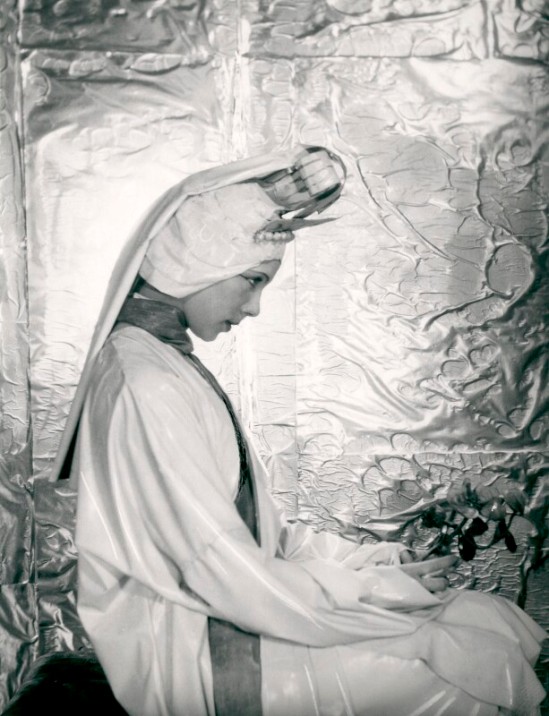
Tilly Losch by Cecil Beaton bromide print, circa 1929 8 1/8 in. x 6 3/4 in. (205 mm x 157 mm) Accepted in lieu of tax by H.M. Government and allocated to the Gallery, 1991 © Cecil Beaton Studio Archive, Sotheby’s London via


Tilly Losch by Cecil Beaton bromide print, circa 1929 8 1/8 in. x 6 3/4 in. (205 mm x 157 mm) Accepted in lieu of tax by H.M. Government and allocated to the Gallery, 1991 © Cecil Beaton Studio Archive, Sotheby’s London via

Erwin Blumenfeld & DADA
Grete Stern (1904-1999) was German born but adopted Argentine nationality after living in the country for 23 years.
In 1948 Stern was offered the unusual assignment of providing photos for a column on the interpretation of dreams in the popular weekly women’s magazine Idilio. The column, entitled “Psychoanalysis Will Help You,” was a response to dreams sent in by readers, mostly working-class women. It was written under the pseudonym Richard Rest by renowned sociologist Gino Germani, who later became a professor at Harvard University. The result was a series of about one hundred and fifty photomontages produced between 1948 and 1951 that show Stern’s avant-garde spirit. In these photomontages she portrays women’s oppression and submission in Argentine society with sarcastic and surreal images. The photomontage was an ideal way for Stern to express her ideas about the dominant values.
It has been claimed that the motivating semiotic principle behind Grete Stern’s photomontages is the need to create a language for women’s dreams; this language may be, in a first instance, sympathetic with the repression and oppression of women, and in a second instance it may be critical of the pscyhoanalytic project with regard to women’s experience.

Grete Stern

Grete Stern
Grete Stern
Grete Stern

Grete Stern
Grete Stern
Grete Stern
Grete Stern
Grete Stern
Little little man, little little man,
set free your canary that wants to fly.
I am that canary, little little man,
leave me to fly.I was in your cage, little little man,
little little man who gave me my cage.
I say “little little” because you don’t understand me
Nor will you understand.Nor do I understand you, but meanwhile,
open for me the cage from which I want to escape.
Little little man, I loved you half an hour,
Don’t ask me again.
Strong and convincing art has never arisen from theories – Mary Wigman
Mary Wigman (1886 – 1973) was a German dancer, choreographer, notable as the pioneer of expressionist dance, dance therapy, and movement training without pointe shoes. She is considered one of the most important figures in the history of modern dance. She became one of the most iconic figures of Weimar German culture and her work was hailed for bringing the deepest of existential experiences to the stage. Wigman, who viewed herself as a dancer of humanity, proved fascinating to painters Emil Nolde and Ernst Ludwig Kirchne. Her dances were often accompanied by world music and non-Western instrumentation, such as fifes and primarily percussions, bells, including the gongs and drums from India, Thailand, Africa, and China, contrasted with silence. She would often employ masks in her pieces, influenced again by non-western/tribal dance.
Mary Wigman
Mary Wigman
Mary Wigman
Mary Wigman
Mary Wigman
Mary Wigman
Mary Wigman
Clips from Totenmal 1929
Mary Wigman performs Hexentanz in 1929
Isadora Duncan (1877 – 1927) is known as the mother of “modern dance,” founding the “New System” of interpretive dance, blending together poetry, music and the rhythms of nature. She did not believe in the formality of conventional ballet and gave birth to a more free form of dance. She ultimately proved to be the most famous dancer of her time.
Duncan’s philosophy of dance moved away from rigid ballet technique and towards what she perceived as natural movement. To restore dance to a high art form instead of entertainment, she sought the connection between emotions and movement:
“I spent long days and nights in the studio seeking that dance which might be the divine expression of the human spirit through the medium of the body’s movement.”
“The dancer’s body is simply the luminous manifestation of the soul.”
Duncan took inspiration from ancient Greece and combined it with an American love of freedom. This is exemplified in her revolutionary costume of a white Grecian tunic and bare feet. Inspired by Grecian forms, her tunics also allowed a freedom of movement corseted ballet costumes and pointe shoes did not. She was very inspired by ancient Greek art and utilized some of those forms in her movement. Duncan wrote of American dancing:
“let them come forth with great strides, leaps and bounds, with lifted forehead and far-spread arms, to dance.”
Her focus on natural movement emphasized steps, such as skipping, outside of codified ballet technique. Duncan also cites the sea as an early inspiration for her movement. Also, she believed movement originated from the solar plexus, which she thought was the source of all movement. It was this philosophy and new dance technique that garnered Duncan the title of the creator of modern dance.
Isadora Duncan
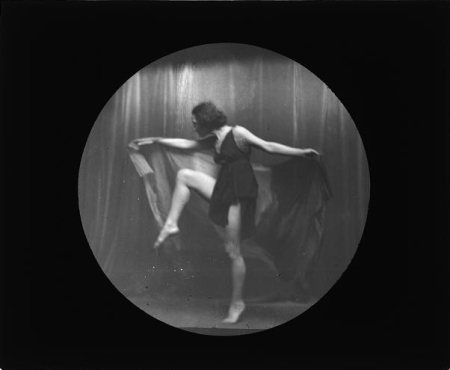
Isadora Duncan
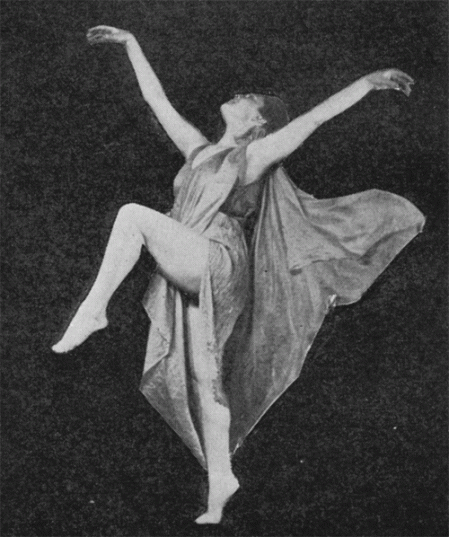
Isadora Duncan
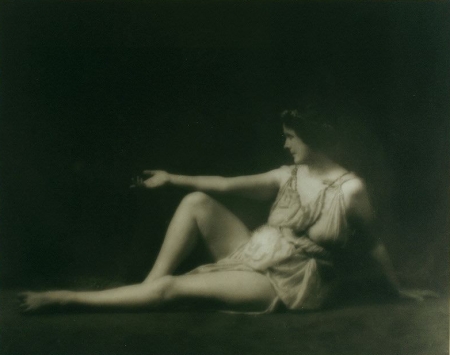
Isadora Duncan

Isadora Duncan
Isadora Duncan
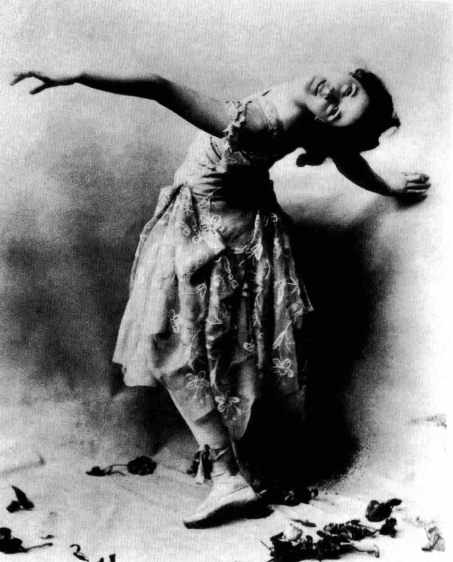
Isadora Duncan
Isadora Duncan
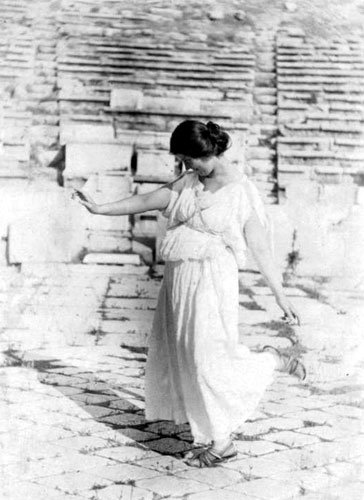
Isadora Duncan
Les papillons japonais, is an early silent era film released in France circa 1908 by Segundo de Chomón who was a pioneering Spanish film director. He produced many short films in France while working for Pathé Frères and has been compared to Georges Méliès, due to his frequent camera tricks and optical illusions. He is regarded as one of the most significant Spanish silent film directosr in an international context.
This film is essentially a genre picture — the sort of stage/film magic hybrid that Georges Melies had pioneered. It is partially hand colored and shows several Japanese characters and eventually a worm change into a butterfly. While flapping it’s wings the butterfly changes colors as it flies, before changing into a girl performing the serpentine dance popular in France and elsewhere at the time.
in the 1890s the amazing serpentine dance became popular throughout Europe and the United States. The new dance was created by Loïe Fuller (1862 – 1928). Fuller was a visionary artist whose novel genre of performance combined billowing costumes with dazzling lights and projections to conjure transformative imagery of hypnotic beauty. Born in Chicago, Fuller embarked on an early theatrical career as an actress and singer in vaudeville, stock companies, and burlesque before developing the dance style that made her famous in the early 1890s. Through experiments with silk drapery and colored lights, she evolved her first Serpentine Dance. Thereafter, the genre became known as “serpentine dancing” and was widely imitated.
Her warm reception in Paris during a European tour persuaded Fuller to remain in France and continue her work. A regular performer at the Folies Bergère with works such as Fire Dance, Fuller became the embodiment of the Art Nouveau movement. Fuller’s pioneering work attracted the attention, respect, and friendship of many French artists and scientists, including Jules Chéret, Henri de Toulouse-Lautrec, François-Raoul Larche, Henri-Pierre Roché, Auguste Rodin, Franz von Stuck, Maurice Denis, Thomas Theodor Heine, Koloman Moser, Stéphane Mallarmé, and Marie Curie.
Although they later became rivals, Fuller helped the career of a young Isadora Duncan. Fuller helped Duncan ignite her European career in 1902 by sponsering independent concerts in Vienna and Budapest.
At the turn of the 20th century, Fuller brought dance to the cutting edge of modernity, and her energy and ambition made her one of the most influential American women of her era. Fuller died in Paris, France, on January 2, 1928.
Loïe Fuller
Loïe Fuller
Loïe Fuller
Loïe Fuller
Portrait of Loïe Fuller, by Frederick Glasier, 1902 via
This is an 1896 film of Fuller performing the dance by pioneering film-makers the Lumière brothers. It gives a hint of what her performance was like. The Serpentine Dance was a frequent subject of early motion pictures, as it highlighted the new medium’s ability to portray movement and light. Many other filmmakers produced their own versions, distributing prints that had been hand-tinted to evoke (though not quite reproduce) the appearance of colored light projection. Fuller also appeared in films by Segundo de Chomon, fx. in the 1908 silent Création de la Serpentine (1908).
Creation of the Serpentine starring Loie Fuller by Segundo de Chomón
Ruth Saint Denis (January 1879 – 1968) was a modern dance pioneer, introducing eastern ideas into the art.
While touring in Belasco’s production of Madame Du Barry in 1904 her life was changed. She was at a drugstore with another member of Belasco’s company in Buffalo, New York, when she saw a poster advertising Egyptian Deities cigarettes. The poster portrayed the Egyptian goddess Isis enthroned in a temple; this image captivated St. Denis on the spot and inspired her to create dances that expressed the mysticism that the goddess’s image conveyed. From then on, St. Denis was immersed in Oriental philosophies.
Like Loie Fuller and Isadora Duncan before her, St. Denis felt that Europe might have more to offer her. She left with her mother for London in 1906, and traveled the continent performing her “translations” until 1909, when she returned to give a series of well-received concerts in New York City and on tour in the United States. During the next five years she continued to tour, building her reputation as an exotic dancer with an artistic bent, a “classic dancer” in the same catagory as Isadora Duncan. These two artists were, however, inherently different in their approach to the solo dance. According to St. Denis’ biographer Suzanne Shelton, Duncan sought “the Self in the Universe,” and St. Denis sought “the Universe in the Self.” For St. Denis, the exotic worlds she intended to interpret could be seen from the vantage point of her body. One of her quotes reads as follows:
I see dance being used as communication between body and soul, to express what is too deep to find for words.
After 1911, the vogue for solo dancers on the professional stage died down. To support herself, St. Denis often gave private lessons to society women, including Gertrude Vanderbilt Whitney. In 1938 St. Denis founded Adelphi University’s dance program, one of the first dance departments in an American university. It has since become a cornerstone of Adelphi’s Department of Performing Arts.
Ruth St. Denis
Ruth St. Denis
Ruth St. Denis
Ruth St. Denis
Ruth St. Denis
Ruth St. Denis
Ruth St Denis is seen here performing the Indian Noche (1932) one of her most famous pieces.